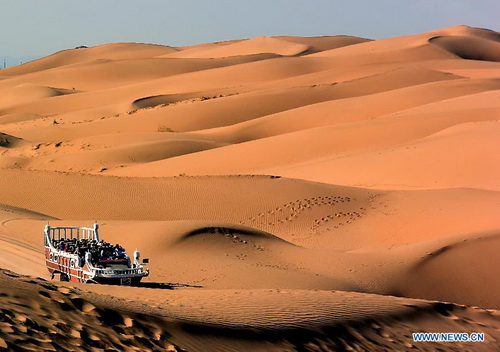
A sightseeing vehicle carrying tourists runs at Xiangshawan (Whistling Dune Bay) in Kubuqi Desert within the territory of Ordos, north China's Inner Mongolia Autonomous Region, Aug. 6, 2015. (Xinhua/Wang Song)
Studies of environmental changes in deserts are of significance for understanding the formation of arid ecosystems, the spread of agriculture and cultures, hydrologic variability, as well as global climate changes. The sedimentological interpretation of aeolian sand deposits in desert systems allows the reconstruction of phases of aeolian activity, their associated ecosystems, or environmental stability and therefore can provide insight into variability in climate systems.
As a significant component of the desert sediment systems, aeolian deposits that also have palaeosols have a high potential for reconstructing regional environmental changes and leading to a fundamental understanding of the formation and evolution of desert systems. Generally speaking, active dunes are associated with low precipitation and lie in arid region. However, China has one active sand sea, the Kubuqi Desert, which is located in a semiarid zone. It is the only active sand sea that lies east of the Helan Mountains. The Kubuqi, meaning "bowstring" in Mongolian, lies to the south of the Yellow River like a long band extending about 400 km from east to west. Generally, the sand dunes of Kubuqi are 10-15 meters high and the active dunes make up 80% of the total area of the Kubuqi Desert. The age, formation, and associated palaeoenvironments of this unique sand sea in semi-arid China remains an environmental secret.
Recently, Prof. YANG Xiaoping's research group from the Institute of Geology and Geophysics, Chinese Academy of Sciences (IGGCAS) and their American collaborator Prof. Steve Forman have jointly investigated the landscape evolution of the Kubuqi Desert in detail and have reveal new insights. Along the stream channels crossing the desert, four aeolian sand/palaeosols sections, which were covered by various fluvial terraces and bedrock landforms, were selected and investigated. Through the identification of four stratigraphic sections, age determination by optically stimulated luminescence (OSL) dating of quartz grains and combined analysis of geomorphology, environmental proxies, local wind data and historical documents, Yang and his group combined gained direct evidence and new insights about the initial formation and age of the Kubuqi Desert.
Compared to the former studies, they think that most of the aeolian sand depositional events occurred within the Holocene (after about 11,700 years). Although the sedimentologic record of aeolian deposition near river channels or former lakes might be older (about 16,000 years), these special aeolian events should be associated with a source-bordering dune, the formation of which should be closely linked to fluvial sediment sources rather than climatic aridity. Thus, it cannot convincingly used as an indicator for the occurrence of the desert landscape in the region, but instead reflects an increase in sediment availability during this period.
In addition, through the comparison of historical documents with field investigation, they obtained an initial insight on the interactions between human activities and palaeoenvironment change since nearly 3000 years ago in the Kubuqi Desert. They suggested that the evolution of desert landscape is not only affected by natural factors, but also closely related to the human activities in this area. Moreover, the existence of cities of Han(206 B.C. – A.D. 220) and Tang(A.D. 608 – 907) dynasties in the desert is evidence of recent environmental changes. The richness of sand availability, strong wind velocity and human activities have all contributed to the formation of the desert landscape Kubuqi region.
This study has recently been published in Geomorphology (Yang, X., Forman, S., Hu, F., Zhang, D., Liu, Z., Li, H., 2016. Initial insights into the age and origin of the Kubuqi sand sea of northern China. Geomorphology 259, 30-39.)

Fig. 1. Upper: Location and wind regime of the Kubuqi Desert. Lower: Sampling sites and locations of sedimentary sections dated by OSL. (Image by YANG et al.)

Fig. 2. The stratigraphy, OSL chronology, and changes of palaeoenvironmental proxies in two sections.(Image by YANG et al.)
Contact:
YANG Xiaoping
Key Laboratory of Cenozoic Geology and Environment,
Institute of Geology and Geophysics, Chinese Academy of Sciences
Phone: 86-10-82998387
E-mail: xpyang@mail.igcas.ac.cn